 Open Access
Open Access
ARTICLE
LSBSP: A Lightweight Sharding Method of Blockchain Based on State Pruning for Efficient Data Sharing in IoMT
1 College of Virtual Reality (VR) Modern Industry, Jiangxi University of Finance and Economics, Nanchang, 330032, China
2 School of Computer Science, Jiangxi University of Traditional Chinese Medicine, Nanchang, 330004, China
3 Jiangxi Tourism & Commerce Vocational College, Nanchang, 330100, China
4 Department of Computer, Mathematical and Physical Sciences, Sul Ross State University, Alpine, TX 79830, USA
* Corresponding Author: Yinxiang Lei. Email:
Computers, Materials & Continua 2025, 82(2), 3309-3335. https://doi.org/10.32604/cmc.2024.060077
Received 23 October 2024; Accepted 06 December 2024; Issue published 17 February 2025
Abstract
As the Internet of Medical Things (IoMT) continues to expand, smart health-monitoring devices generate vast amounts of valuable data while simultaneously raising critical security and privacy challenges. Blockchain technology presents a promising avenue to address these concerns due to its inherent decentralization and security features. However, scalability remains a persistent hurdle, particularly for IoMT applications that involve large-scale networks and resource-constrained devices. This paper introduces a novel lightweight sharding method tailored to the unique demands of IoMT data sharing. Our approach enhances state bootstrapping efficiency and reduces operational overhead by utilizing a dual-chain structure comprising a main chain and a snapshot chain. The snapshot chain periodically records key blockchain states, allowing nodes to synchronize more efficiently. This mechanism is critical in reducing the time and resources needed for new nodes to join the network or existing nodes to recover from outages. Additionally, a block state pruning technique is implemented, significantly minimizing storage requirements and lowering transaction execution overhead during initialization and reconfiguration processes. This is crucial given the substantial data volumes inherent in IoMT ecosystems. By adopting an optimistic sharding strategy, our model allows nodes to swiftly join the snapshot shard, while full shards retain the complete ledger history to ensure comprehensive transaction verification. Extensive evaluations across diverse shard configurations demonstrate that this method significantly outperforms existing baseline models. It provides a comprehensive solution for IoMT blockchain applications, striking an optimal balance between security, scalability, and operational efficiency.Keywords
As people increasingly incorporate smart devices into various aspects of their lives from medical technologies and wearables to entertainment, these devices not only enhance daily experiences but also generate vast amounts of valuable data. However, this rapid digital integration brings elevated security and privacy concerns, particularly in the Internet of Medical Things (IoMT). IoMT devices, which often linked through multiple interfaces, are especially vulnerable to security breaches, presenting significant risks in sectors handling sensitive data.
To address these concerns, there is an urgent need for robust frameworks that safeguard IoMT data. Blockchain technology, with its decentralized, immutable, and traceable characteristics, offers a promising solution. The BFLDL scheme [1] integrates blockchain with federated learning, providing a secure, privacy-preserving approach for applications like deepfake detection. Beyond cryptocurrency, blockchain is increasingly recognized as a foundational technology in the digital economy, extending to areas like smart homes [2], smart cars [3], and the IoMT [4] among others. Despite its wide applicability, blockchain technology encounters significant scalability challenges. Traditional blockchains like Bitcoin and Ethereum, are limited to processing only 7 and 15 transactions per second (TPS), respectively [5]. Such throughput is inadequate for modern applications requiring processing capabilities exceeding 100,000 TPS. The main bottleneck is that all nodes must maintain a complete copy of the ledger.
Sharding technology is recognized as an effective approach to tackle this issue. However, current research on sharding technology faces several challenges when applied to modern sectors. First, there is substantial overhead associated with bootstrapping blockchain sharding states. Sharding technology utilizes a reshuffle committee that periodically updates the verification members in each shard to prevent malicious nodes from gaining control and to enhance security. This reconfiguration, however, increases the time overhead of state synchronization during the sharding process. Second, the blockchain ledger’s continuously growing data capacity poses further challenges. For instance, in the IoMT sector, the growing number of health-conscious individuals results in large volumes of data generated by medical devices. The medical blockchain struggles to process this large capacity of data, imposing a significant burden on the network, and the overhead incurred during the blockchain bootstrap phase becomes increasingly substantial. Lastly, the practical value of excessively old data stored across different shards diminishes, leading to increased validation costs. The involvement of numerous historical transactions and complex verification logic results in relatively high costs for validating outdated data.
To tackle these challenges, this paper presents a Lightweight Sharding method of Blockchain based on State Pruning (LSBSP) aimed at enhancing data sharing efficiency in the IoMT. LSBSP optimizes state management by utilizing a dual-shard architecture, comprising snapshot shards for accelerated transaction processing and full shards to ensure data integrity. This approach significantly reduces both storage and computational demands across network nodes, promoting more efficient operation within the network. The main contributions of this paper are:
• We present a lightweight blockchain sharding method tailored to address the significant challenges of state bootstrapping load and time overhead in efficient data sharing, where both safety and efficiency are paramount.
• We introduce a block state pruning technique that optimizes resource utilization during initialization and reconfiguration phases. This technique reduces storage disk space requirements and enhances transaction execution efficiency, which is essential for managing large data volumes.
• Extensive simulation experiments validate the effectiveness of the LSBSP scheme. The results demonstrate its superior performance in key areas, including system storage capacity, throughput, and latency, outperforming other comparative approaches.
The rest of this article is organized as follows: Section 2 reviews the relevant background literature. We introduce the problem formulation in Section 3. In Section 4, we present the definition and proposed algorithm. Section 5 conducts mathematical analysis and discussion. The experimentation evaluation is illustrated in Sections 6, and 7 concludes the paper with insights and directions for future work.
2.1 Blockchain Sharding Method
Sharding technology is recognized as a promising solution for addressing scalability issues in blockchains. Luu et al. [6] introduced the Elastico protocol, which divides the network into smaller committees to process distinct sets of transactions in parallel. However, Elastico faces challenges with cross-shard transactions, potentially leading to rejection and deadlocks. To address this, Kokoris-Kogias et al. [7] proposed OmniLedger, combining RandHound with the verifiable random function (VRF) algorithm. Rapidchain initially proposed a public blockchain sharding method capable of resisting up to 1/3 of Byzantine participants by leveraging the cuckoo rule and employing efficient cross-shard transaction verification technology routing [8]. However, both methods above require storing the complete blockchain ledger [9].
To enhance blockchain security, Federated Learning (FL) is often combined with blockchain technology to create a trusted environment for secure data transmission and privacy protection [10,11]. Zhen et al. [12] propose a blockchain architecture that leverages deep reinforcement learning for dynamic state storage to boost the performance of blockchain-based crowd sourcing systems. This architecture is designed to increase the blockchain’s throughput and the proportion of non-malicious nodes, thus enhancing its resistance to attacks. Free2Shard proposes a dynamic self-allocation strategy to maintain a favorable ratio of honest to hostile nodes in each shard [13]. PolyShard [14] uses polynomial-coding to address scalability, security, and decentralization challenges. Li et al. [15] presented a secure and efficient blockchain sharding scheme that combines hybrid consensus with dynamic management, enhancing scalability and security while optimizing performance and preserving resilience against attacks. Reticulum [16] introduces a two-layer sharding design, comprising “control” and “process” shards, manage security and liveness attacks separately while dynamically adjusting transaction throughput, significantly improving scalability without compromising security.
Vakili et al. [17] introduced a service composition approach for cloud-based IoT environments that leverages Grey Wolf Optimization and MapReduce frameworks. The optimization framework aligns with blockchain sharding’s goal of enhancing system efficiency through resource allocation strategies. Integrating Vakili et al.’s optimization principles could help improve transaction handling and load distribution across blockchain shards, addressing similar challenges of large-scale, decentralized environments that require rapid processing and adaptability.
For cross-shard transactions, when coordinating intra-shard and cross-shard consensus protocols, transaction ordering may expose the system to attacks. Haechi [18] introduces a final fairness algorithm to accommodate consensus speed differences across shards, ensuring global fair ordering, which enhances system consistency and parallel processing capabilities. The global order provided by Haechi ensures strong consistency between shards and improves parallelism in handling cross-shard conflicting transactions. Xu et al. [19] propose the X-shard method, which decomposes transactions into sub-transactions to reduce processing delays. Tao et al. [20] introduce a distributed sharding system based on smart contracts to resolve conflicts among miners in large shards. GriDB designs an off-chain mechanism for cross-shard operations, ensuring database service verification [21].
These studies contribute to enhancing blockchain security and reducing cross-shard communication overhead. However, the growing size of state ledgers increases the time for bootstrapping the ledger, impacting transaction processing efficiency.
2.2 Blockchain Storage Technology
The burgeoning growth of blockchain ledger sizes presents substantial computational and storage challenges for new nodes, with the sizes of Bitcoin and Ethereum ledgers exceeding 500 and 700 GB, respectively [22]. This data storage issues have garnered substantial attention. Traditionally, new nodes are required to download all blocks and re-execute transactions, leading to redundant computations and inefficient hardware utilization [23].
Recent approaches focus on reducing storage consumption through on-chain and off-chain methods. Light node technology, such as Simplified Payment Verification (SPV), stores only essential transaction data, minimizing the need for full node storage. CoinPrune introduces block pruning, allowing nodes to sync with recent snapshots of the ledger [24], however, this approach overlooks potential validation failures. FHFBOA optimizes storage by transforms the storage challenge into a multi-objective optimization problem [25].
To address data redundancy, Chunk2vec [26] introduces an advanced similarity detection scheme that utilizes deep learning and Approximate Nearest Neighbor Search. This method identifies similar data chunks across a predefined similarity threshold by analyzing fingerprint feature vectors. Furthermore, deep learning plays a crucial role in ensuring integrity and security in blockchain storage. Heidari et al. [27] reviewed deep learning-based methods for deepfake detection, highlighting their effectiveness in authenticity verification and combating malicious alterations. These techniques could be adapted to enhance blockchain storage by providing robust mechanisms for data integrity across distributed networks.
Coding techniques also enhance storage efficiency, such as erasure-correcting codes [28]. Qi et al. propose a Byzantine fault-tolerant storage engine leveraging error correction and replication modes [29]. Huang et al. [30] proposed the SnapshotPrune scheme, which improves the synchronization strategy based on the existing snapshot model to accommodate the UTXO pruning strategy, enabling nodes in the Bitcoin blockchain to quickly achieve state synchronization. Kumar et al. [31] aimed to improve the security of industrial image and video data by utilizing the distributed storage capabilities of IPFS and the tamper-proof nature of blockchain. S-BDS [32] constructs a storage sharding scheme for IoT data based on blockchain, replacing the Merkle tree in the blockchain data layer with Insertable Vector Commitment (IVC) to effectively reduce communication congestion. Additionally, Yang et al. [33] proposed a blockchain-based file storage mechanism that limits the selfish behavior of nodes.
Existing research often focuses solely on blockchain sharding technology without considering the impact of ledger capacity, or concentrates on optimizing blockchain ledger capacity while neglecting scalability issues. There is currently a lack of work that integrates blockchain sharding technology with ledger capacity management. To address this, the LSBSP solution aims to tackle the issues of blockchain ledger expansion and limited scalability, making it more suitable for blockchain systems in scenarios such as the IoMT. A comparison of related work is shown in Table 1.

Using the sharing of EHR data as an example, the current exchange healthy data faces several critical challenges that urgently need to be addressed.
C1: Stringent Security Requirements.
Medical data carries sensitive information such as personal privacy, health conditions, and potential treatment plans, thus necessitating extremely high security standards. In the process of medical data sharing, multiple and stringent security measures must be implemented to ensure the integrity and privacy of the data remain intact and uncompromised.
C2: Pursuit of Efficient Data Processing.
In the medical field, the accuracy and timeliness of data are critical for diagnosis and treatment. Therefore, the efficiency of medical data processing is of utmost importance. It must be capable of quickly and accurately acquiring, analyzing, and transmitting data to support rapid medical decision-making and service response.
C3: Massive Data Volume Challenge.
With the continuous advancement of medical technology and the increasing level of informatization, medical data is experiencing explosive growth. This data includes vast amounts of medical records, high definition imaging data, and complex genomic sequencing information, resulting in enormous data volumes. Therefore, medical blockchain data sharing systems need efficient data storage and management capabilities to support quick access to massive amounts of data.
Based on the analysis of the challenges in medical data sharing, the proposed solution of the LSBSP scheme is as follows:
S1: Enhancing Data Security
Utilizing the immutability of blockchain and powerful consensus algorithms, the aim is to ensure the integrity and privacy of medical data during the sharing process, significantly enhancing data security.
S2: Improving Data Sharing Efficiency
By employing blockchain sharding technology, the aim is to enhance the processing and transmission efficiency of medical data. This approach addresses the high demands for data accuracy and timeliness in the medical field, supporting rapid medical decision-making and prompt service responses.
S3: Reducing Storage Requirements for Verification Nodes
Through snapshot-based state pruning, the objective is to reduce the storage requirements of blockchain verification nodes. This effectively lowers the data storage burden on validators, accommodating the explosive growth of medical data.
3.2 Safety EHR Sharing Instances
Fig. 1 illustrates a secure and efficient EHR sharing instance that combines blockchain sharding technology. This model can be divided into three phases: data generation, data management, and data utilization.
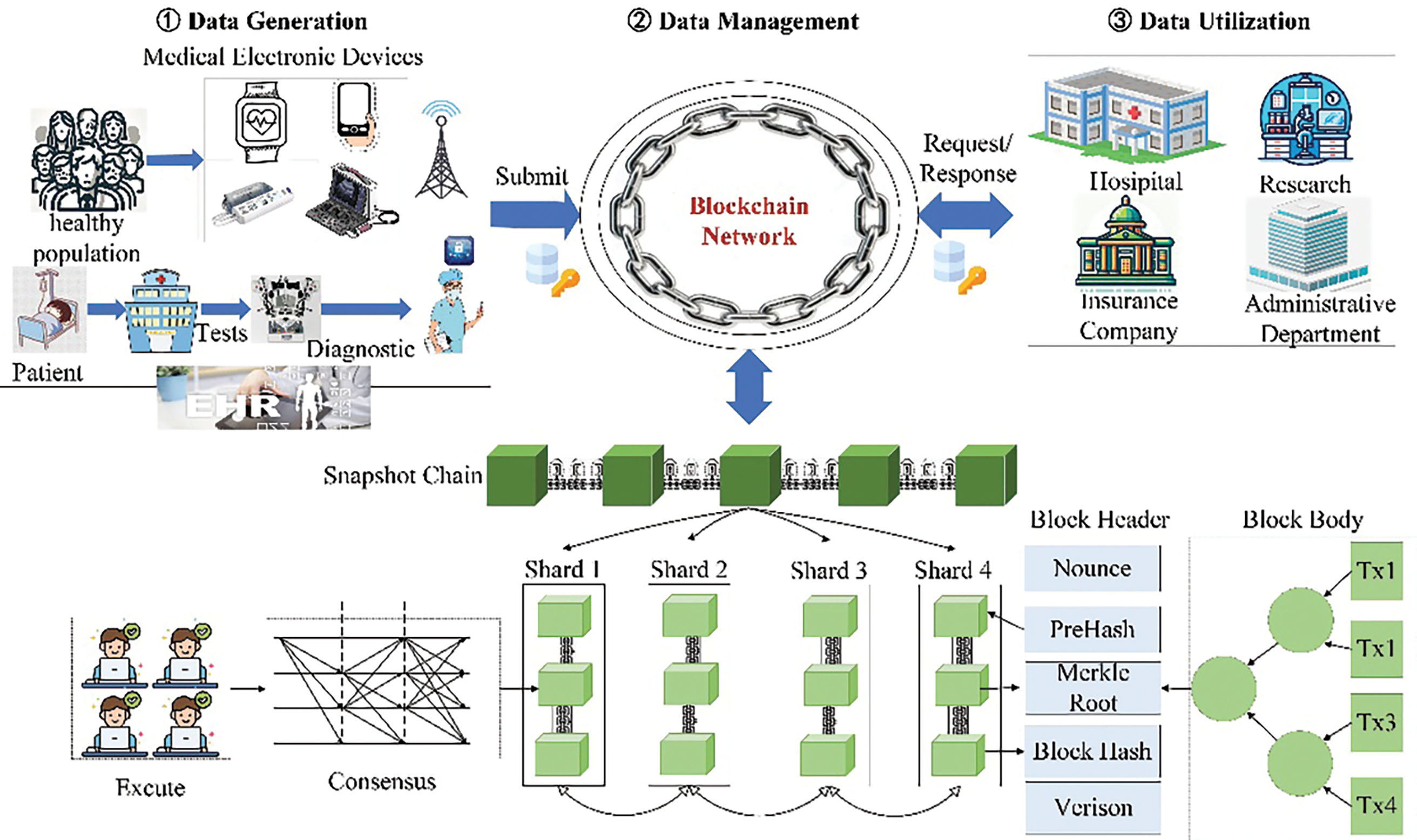
Figure 1: A safety EHR sharing instances
In the data generation phase, two prominent trends emerge alongside the growing emphasis on health issues. First, patients undergo a series of medical examinations upon admission, enabling doctors to make diagnoses based on the results. Second, individuals in sub-health states actively utilize various portable medical devices to track their health status. These electronic health records (EHRs) are invaluable to both patients and society. To ensure the secure sharing of EHRs, blockchain technology can be employed to manage this data. Data providers upload information to the blockchain after obtaining the patient’s consent, thus safeguarding sensitive data and improving processing efficiency.
During the blockchain data management phase, the sharding method can be adopted to improve scalability. All transactions are structured in the form of a Merkle tree, with leaf nodes containing EHR information. If any changes occur to the EHRs, the Merkle root R will be altered, ensuring data integrity through cryptography. Let
All nodes in a shard will execute the transaction and reach consensus. The consensus algorithm guarantees that no unauthorized modifications to the EHRs can occur. By employing the sharding method, the scalability of the blockchain is significantly enhanced, ensuring quick access to data.
In the data utilization phase, relevant individuals and institutions can apply for access to pertinent data via the blockchain. With access to comprehensive medical histories, healthcare providers can make more accurate and timely diagnoses. Sharing EHRs eliminates the need for redundant tests and examinations. When patients transition between different healthcare providers, their complete medical records are readily available, reducing unnecessary procedures and lowering healthcare costs. Furthermore, shared EHR data enables healthcare specialists to collaborate more effectively. This coordinated approach ensures that all aspects of a patient’s health are considered, leading to more cohesive and efficient treatment plans.
To reduce the storage requirements for network nodes as large volumes of data are generated, we have innovatively proposed a lightweight blockchain sharding method based on state pruning (LSBSP) for secure data management and sharing.
The implementation of sharding technology significantly boosts the performance of blockchain systems. Let
where
Let
where
Each shard processes transactions in defined timeframes, or epochs. Let
Fig. 2 shows an overview of LSBSP. This model incorporates a dual-chain structure consisting of
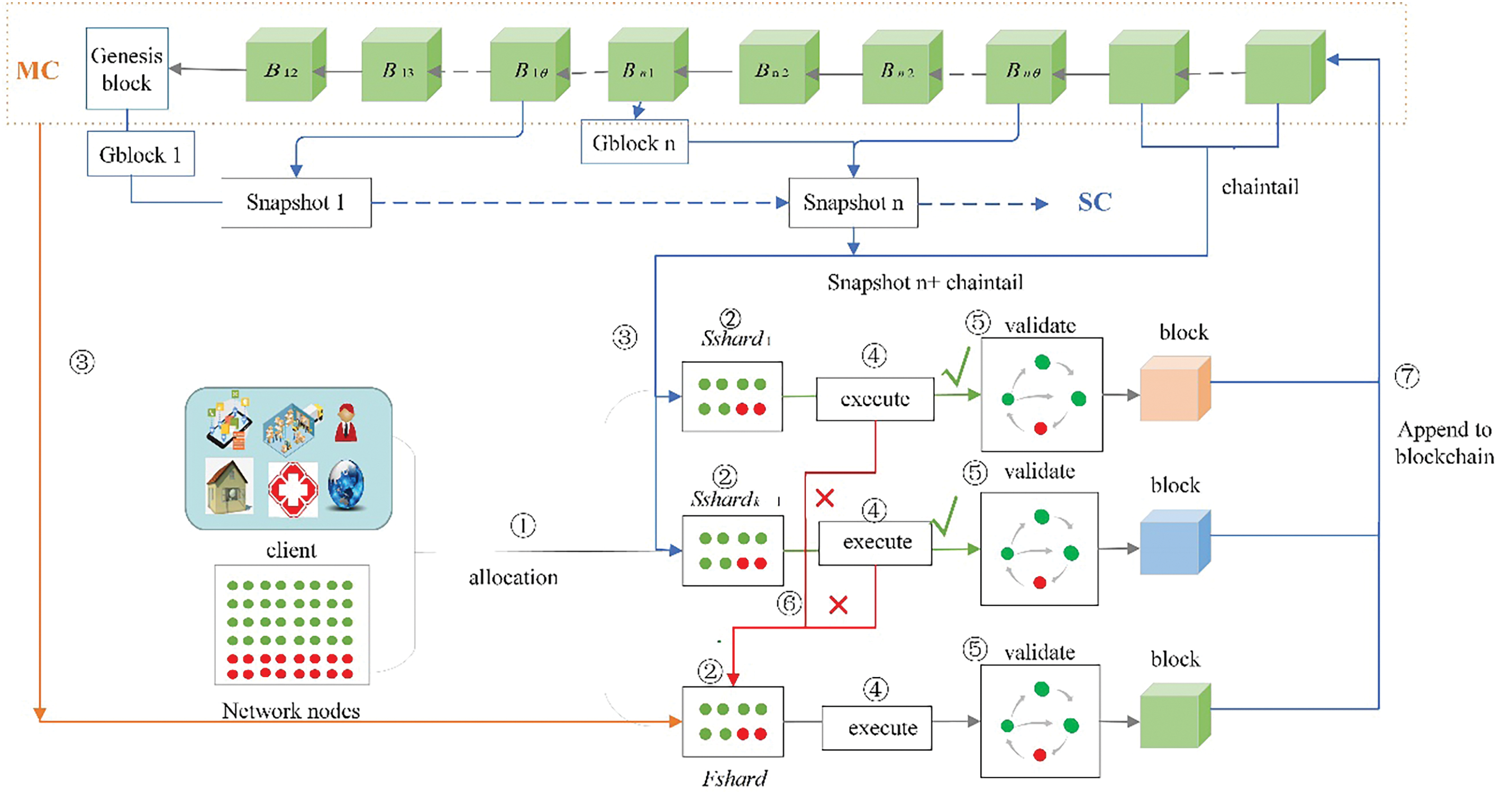
Figure 2: An overview of LSBSP
Step①: Transaction generation and node assignment. A transaction
Step②: Configuration of the shards. The LSBSP configuration’s specification of
Step③: State initialization. In this step, the validators in Sshard begin by loading the ledgers
Step④: Transaction Execution. Transactions are executed in parallel across the shards. Successful executions in Sshard move to Step 5, while failures are redirects to Fshard, subsequently leading to step 6.
Step⑤: The transaction
Step⑥: Transaction Processing in Fshard. Fshard re-executes the transactions that failed in Sshard and subsequently returns to Step 5 for verification.
Step⑦: Update. The valid block
We introduce a novel sharding blockchain architecture that comprises two distinct chains: the
where
Definition 1 (Main Chain, MC). The Main Chain can be represented as a sequence of blocks,
Definition 2 (Snapshot Chain, SC). The Snapshot Chain
Definition 3 (Full Shard, Fshard). A Full Shard, denoted as Fshard, consists of nodes that fully replicate the ledger from the main chain
Definition 4 (Snapshot Shard, Sshard). Snapshot shards, denoted as Sshard, consist of nodes that retrieve their ledgers from the
where n represents the number of the latest snapshot.
The concept of a “chaintail” is derived from Coinprune [24] and refers to the collection of all blocks that appear on the
Definition 5 (Bootstrapping). For each node
Definition 6 (Epoch). An epoch
The state of the
1) Snapshot data structure
The structure of the snapshot is illustrated in Fig. 3, it consists of a header and a body. The header includes the snapshot number
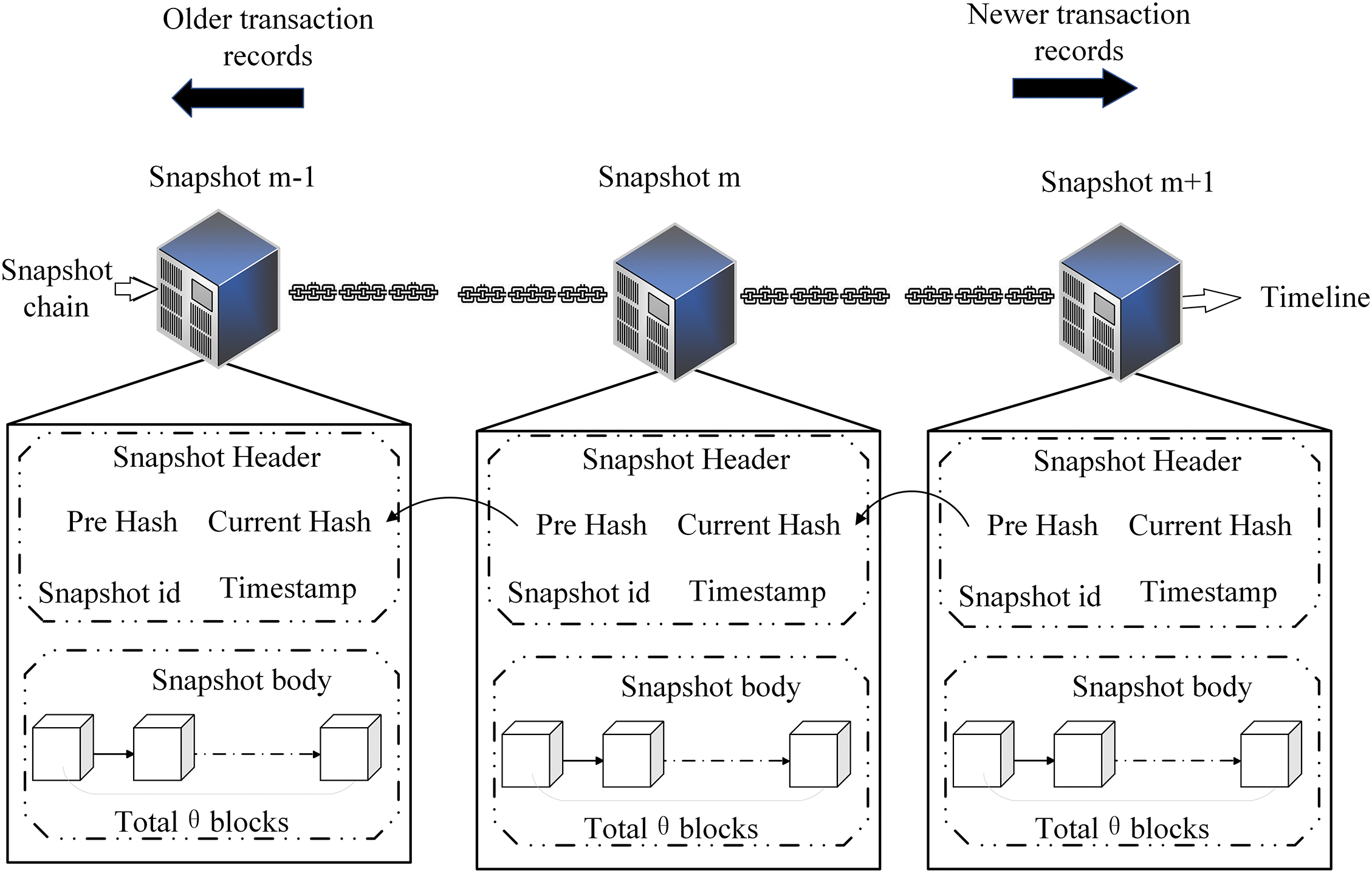
Figure 3: The graph of snapshot data structure
where
Definition 7 (Snapshot start timestamp). The start timestamp of the snapshot
Definition 8 (Snapshot end timestamp). The end timestamp of the snapshot, denoted as
The snapshot timestamp comprises both a start timestamp and an end timestamp, denoted as
2) Create a snapshot.
The generation of the snapshot is triggered when the count of blocks between the current block and the initial block of the snapshot, denoted as
As shown in Fig. 2, the initial block of the
3) Snapshot synchronization.
The synchronization process for snapshots ensures alignment between the most recent state of the SC and the state of the
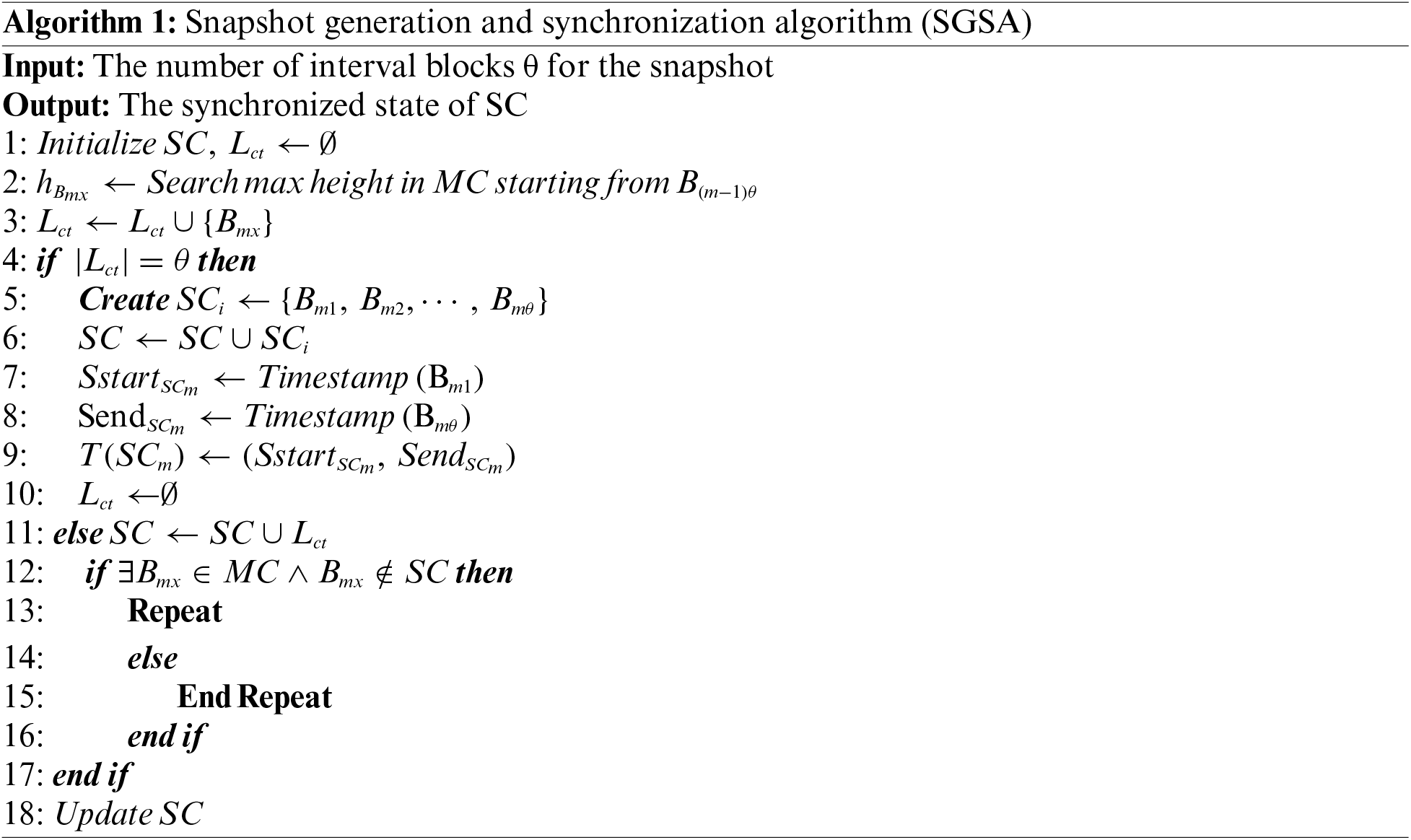
In Algorithm 1, the process begins by searching for the block with the maximum height
Next, the timestamps for the snapshot are updated, setting
If the number of blocks in the chaintail is less than
4) Snapshot Chain Maintenance.
In the LSBSP framework, maintaining the snapshot chain is essential for ensuring the integrity and consistency of the blockchain. Once a snapshot
Next, nodes compute the hash value of the snapshot using the following formula:
Additionally, nodes must verify that all blocks included in the snapshot
This step ensures that the blocks are not only present but also in the correct order, thereby maintaining the integrity of the snapshot in relation to the
4.4 State Pruning Bootstrapping
Operating in an untrusted environment presents security challenges, especially from potentially malicious nodes. To counter these, the blockchain network employs a distributed random mapping function
State pruning in the blockchain system aims to reduce storage and computational demands by retaining only the essential states for ongoing operations. To balance the workload between the Sshard and the Fshard, we define a load balancing function
Our objective is to achieve
Node states are bootstrapped to ensure consistent, accurate data across the network. Let
The model incorporates a continuous alignment mechanism with the
1) State data flow.
In Fig. 4, the dashed line delineates the state data flow among the various shards. The
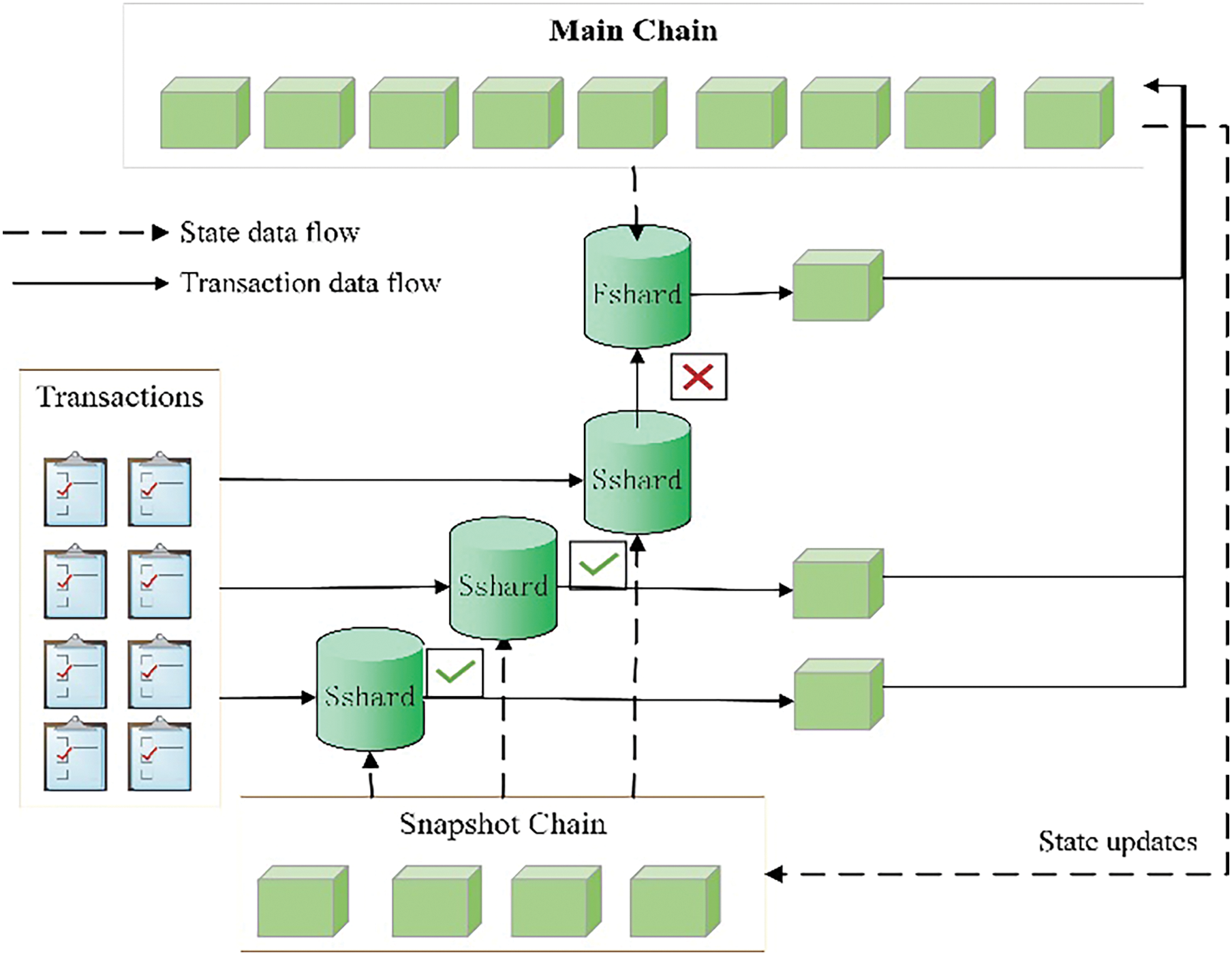
Figure 4: The state bootstrapping process of Fshard and Sshard
Here’s a comprehensive breakdown of the process: Initially, the verifier in Sshard performs a thorough search in the
2) Transaction data flow.
The transaction initially undergoes processing in the Sshard. If it fails to pass validation, it is forwarded to the Fshard for further execution. The Fshard maintains a comprehensive ledger of the blockchain, ensuring robust verification of transactions. This strategy efficiently resolves challenges related to transaction verification failures. Within a shard, nodes dynamically bootstrap their state ledgers, keeping them up-to-date as new blocks are appended to
In LSBSP, the state block pruning method is adopted to dynamically maintain the state ledger, thereby enhancing its efficiency and scalability. The Snapshot-based State Bootstrapping Algorithm (SBA), outlined in Algorithm 2, facilitates the loading of distinct state ledger data based on the shard type of each node, optimizing the process and ensuring seamless integration across the network.
In Algorithm 2, the process begins by initializing the snapshot chain
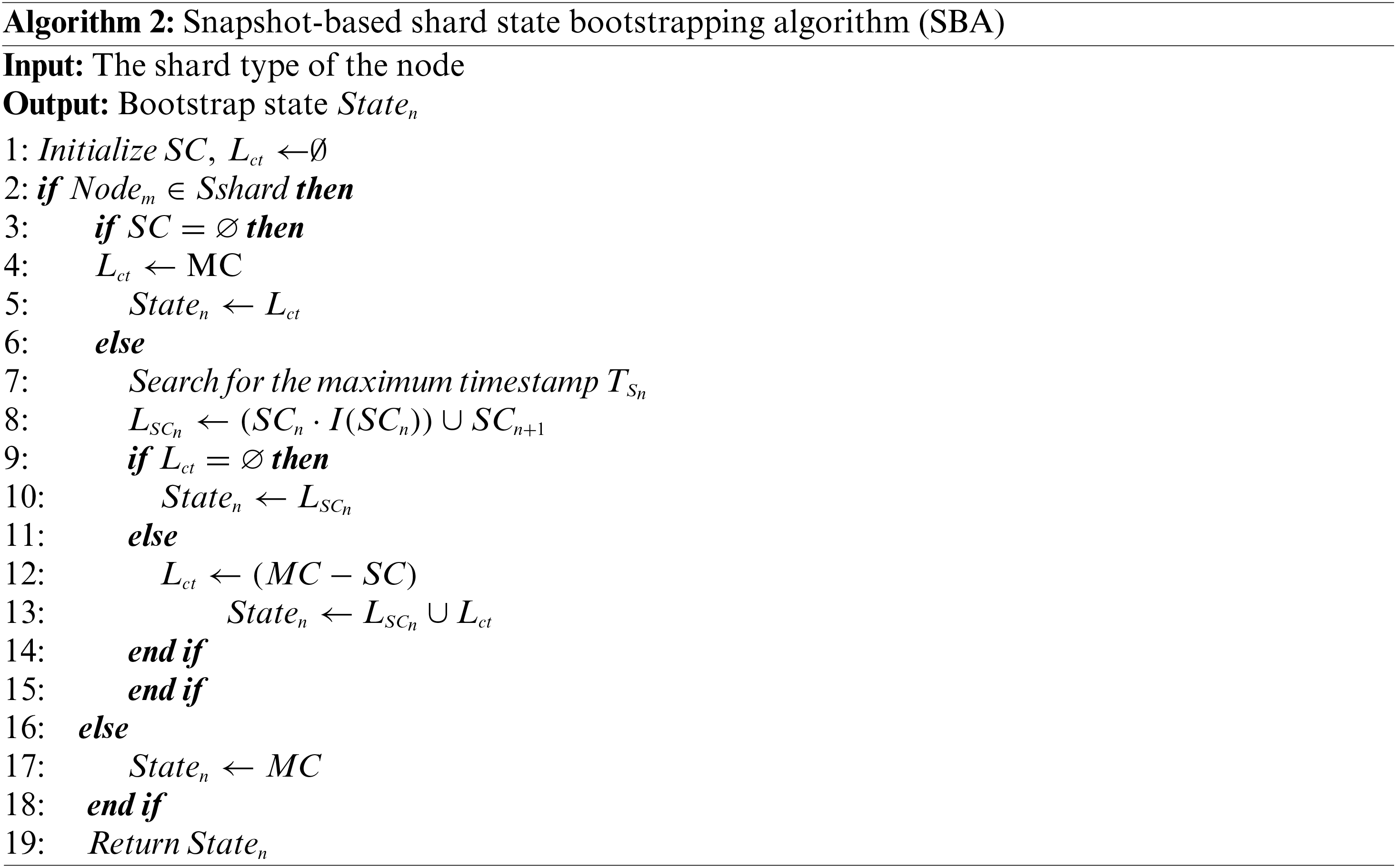
5 Mathematical Analysis and Discussion
This section presents a comprehensive performance analysis of the LSBSP scheme, focusing on consistency, bootstrap time overhead, scalability and security.
Theorem 1: The LSBSP scheme guarantees that for all transactions
Proof: After pruning,
Transactions are initially validated against the
Let
If a transaction is inconsistent, it implies that the
Assuming nodes sample from a uniform distribution, the expected number of conflicts can be defined as:
where
As
This means that as the number of nodes grows, the likelihood of inconsistent transactions approaches zero.
5.2 Bootstrap Overhead Analysis
Generally, when considering the “Gen_shard” protocols and provided that
The LSBSP protocol incorporates a
where
Upon comparing Eqs. (25) and (27), it becomes evident that the time required for bootstrapping in the LSBSP protocol is substantially less than that needed in the Gen_shard protocol.
The LSBSP approach demonstrates superior scalability compared to the No_shard scheme due to its ability to concurrently process transactions across multiple shards.
No_shard Method. In the No_shard framework, let
The LSBSP utilizes
To demonstrate scalability, the analysis focuses on how the throughput of the LSBSP scheme scales with the number of shards
This relationship indicates that the throughput of the LSBSP scheme is directly proportional to the throughput of the No_shard scheme, scaled by a factor of
Assuming all shards operate independently and efficiently, the overall scalability of the LSBSP scheme can be expressed in terms of its throughput as:
This linear scaling persists as long as there are sufficient resources and transactions to keep all shards active. Let
This attribute is particularly important in environments such as IoMT data sharing, where high scalability is essential for timely data access and processing.
The assignment of nodes to shards in the LSBSP scheme is modeled as a random sampling problem, which can be simulated using a binomial distribution. Let
A shard is considered dishonest if the proportion of malicious nodes
Theorem 2: Given a shard of size
Proof: Using the Chernoff bound, it is possible to bound the probability that the number of malicious nodes
where
As
This section presents a comprehensive performance evaluation of the proposed scheme through simulation experiments on a payment system. The blockchain in this system securely records transfers and balance changes across all accounts. All simulations were performed on a Windows 11 operating system, leveraging an Intel(R) Core(TM) i9-12900 K processor and 64 GB of RAM.
In the simulation setup, a blockchain system was implemented to store transfer records, account balances, and verify blocks. Each shard proposing a block for parallel verification at each epoch t, with experiments replicated 20 times to ensure accuracy.
Simulations were run on a single computer with network nodes
To benchmark the performance of the proposed sharding scheme, three comparative schemes were employed:
1) No_shard. In this scheme, all nodes within the network maintain an complete replica of the blockchain and process transactions sequentially.
2) Gen_shard. This approach employs sharding to partition network nodes while maintaining a complete copy of the blockchain ledger without pruning. Each shard independently processes non-overlapping transactions.
3) PolyShard. The PolyShard protocol [14] employs polynomial coding computing technology to enhance the scalability of existing blockchains. It introduces computational redundancy in the form of unconventional coding to address failures.
6.2 Scalability Analysis of the Scheme
In the scalability experiment, the relationship between the number of network nodes, the number of epochs, and the system’s throughput is explored. Specifically, 2000 epochs are conducted, and the number of network nodes is gradually scaled up from 40 to 200 to assess the system’s scalability and observe changes in throughput. The number of nodes in each shard remains constant.
Fig. 5 provides a comprehensive comparison of the throughputs achieved by different schemes across varying epochs and node counts. The results are presented in four distinct subplots, each focusing on a specific strategy: (a) No_shard, (b) Gen_shard, (c) PolyShard, and (d) LSBSP.
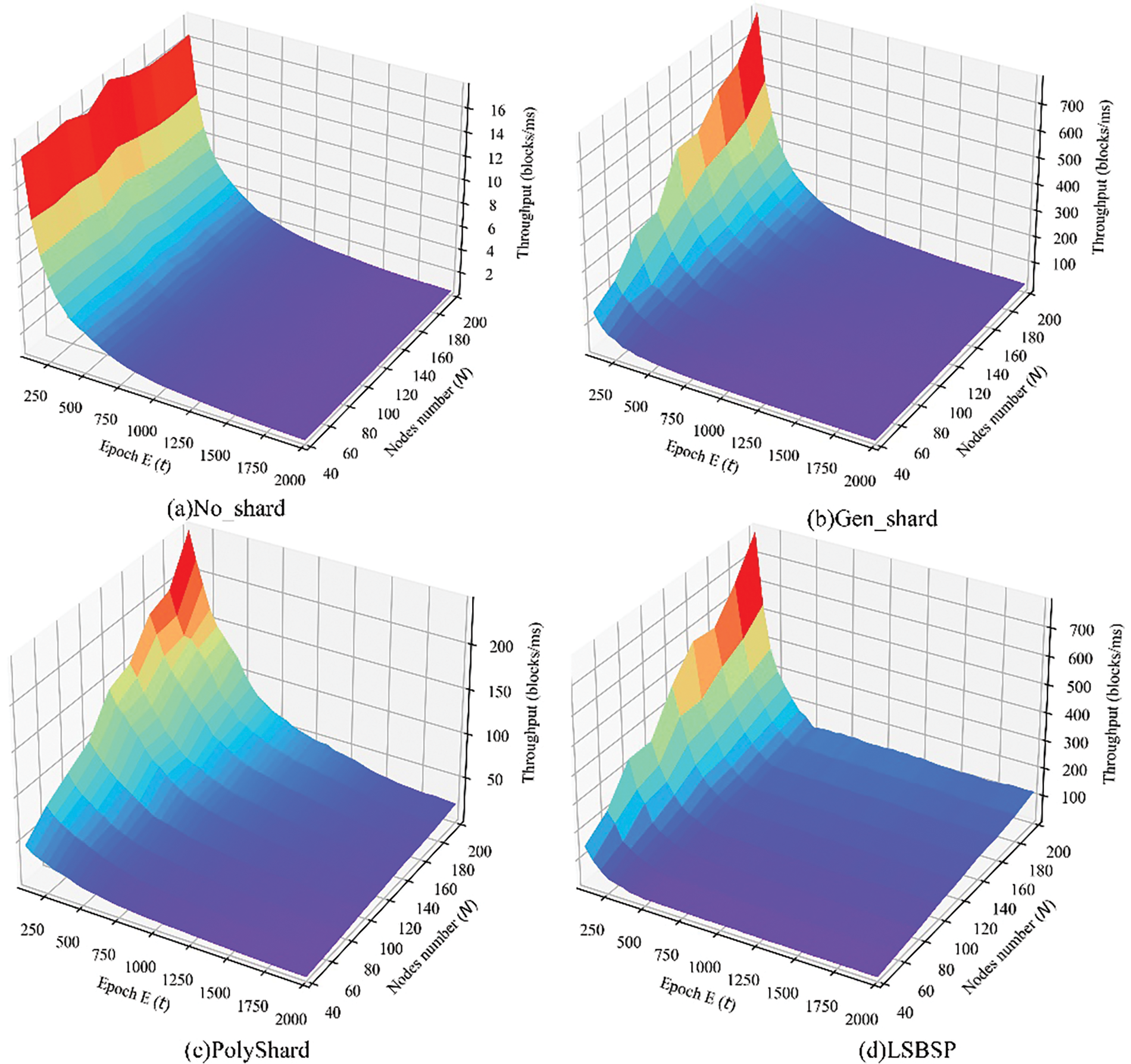
Figure 5: Comparison of throughput across different epochs and varying node counts
To improve observation and understanding, Fig. 6 illustrates the relationship between throughput and the number of epochs across different schemes, with the shard count set to (a)
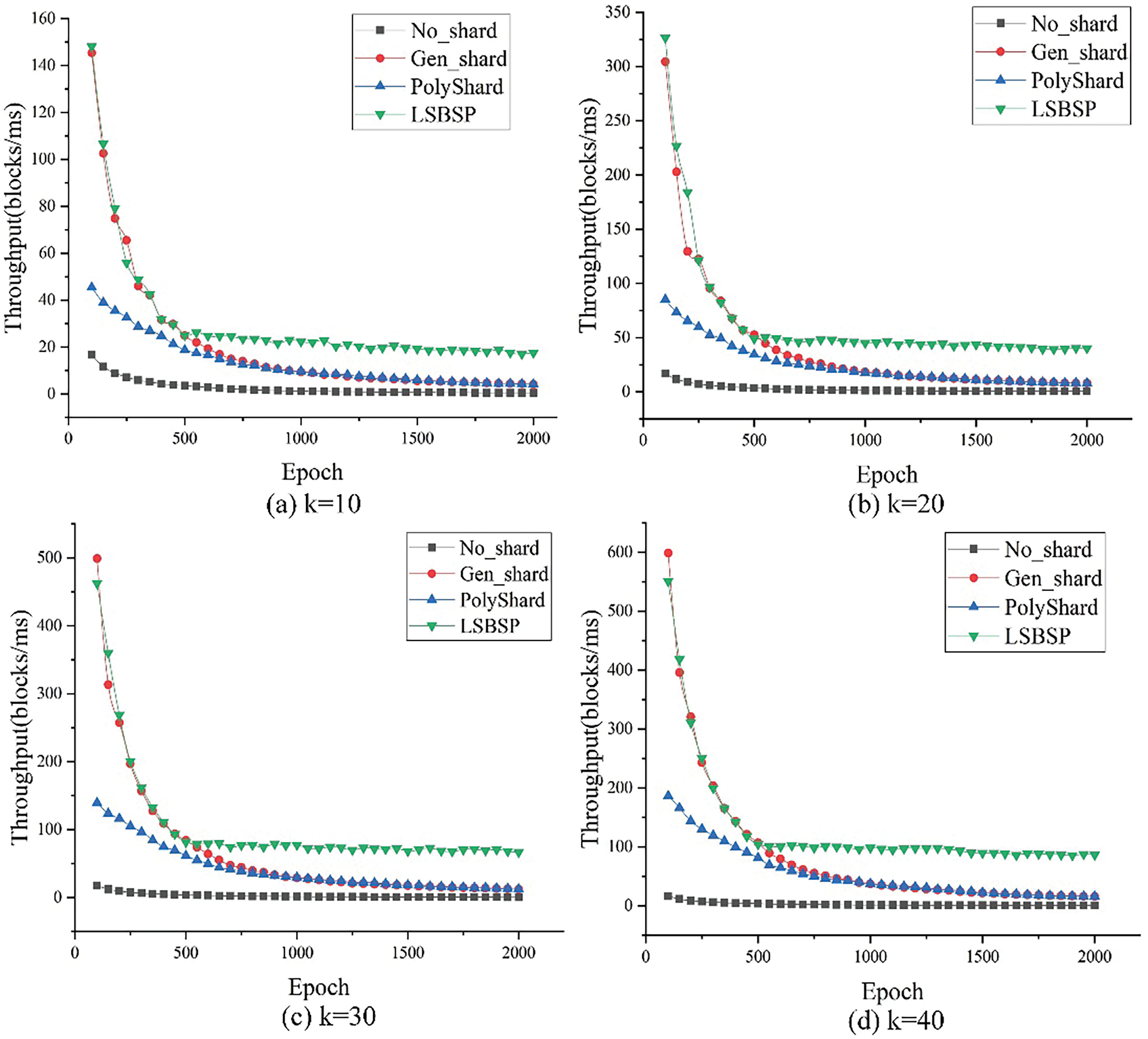
Figure 6: The correlation between throughput and various epochs across different schemes
The No_shard scheme shows limited scalability with stagnant throughput as node counts increase across all epochs. This is due to each node processing every transaction in the network, making the system prone to congestion and longer transaction delays as transaction volumes rise.
Both Gen_shard and PolyShard protocols increased achieve higher throughput as the network expands due to node partitioning and parallel processing of distinct transactions. However, as more blocks are added over successive epochs, the increased storage and computational demands lead to a throughput decline.
The LSBSP scheme demonstrates particularly evident superior scalability when the number of nodes increases and the epoch size is large, resulting in a rapid surge in throughput. This performance is driven by the implementation of pruning block technology, which periodically trims the
Fig. 7 clearly illustrates the relationship between throughput and the number of nodes across the four schemes when
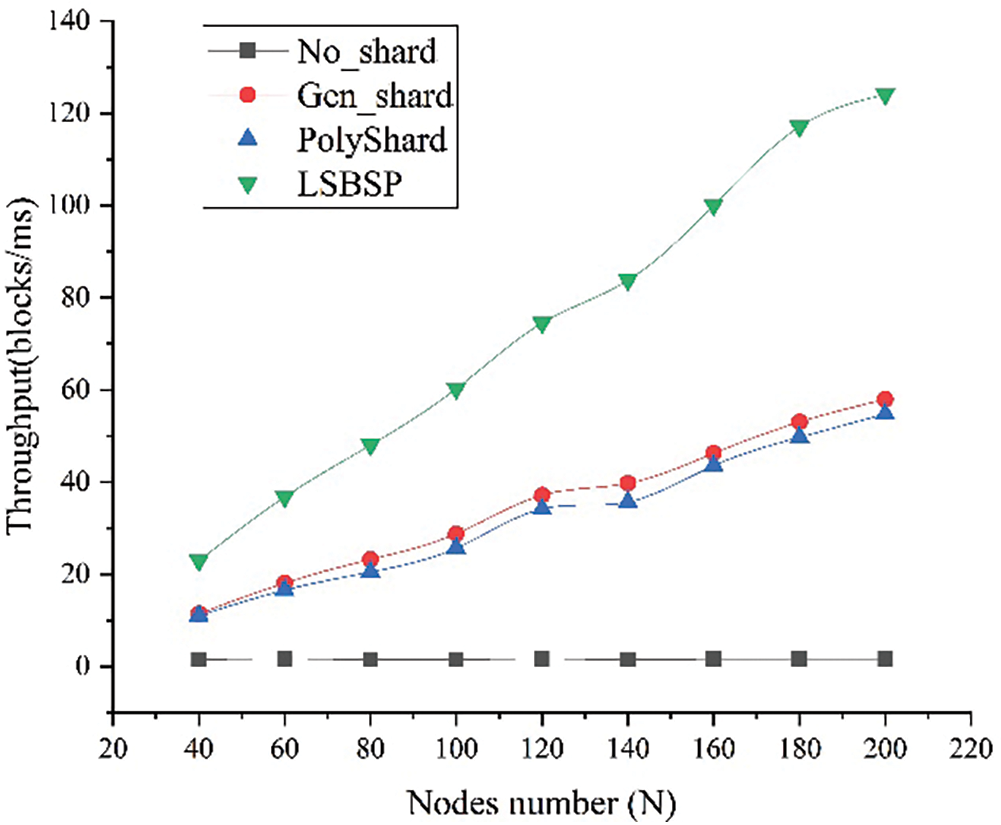
Figure 7: Throughput vs. the number of nodes for the four schemes
6.3 Latency Comparison of Different Shards
In this section, we conduct experiments to analyze latency across different shard counts within four distinct schemes. Tests were performed by varying the shard counts to precisely evaluate the impact on processing times. The results are displayed in Fig. 8, featuring subplots for (a)
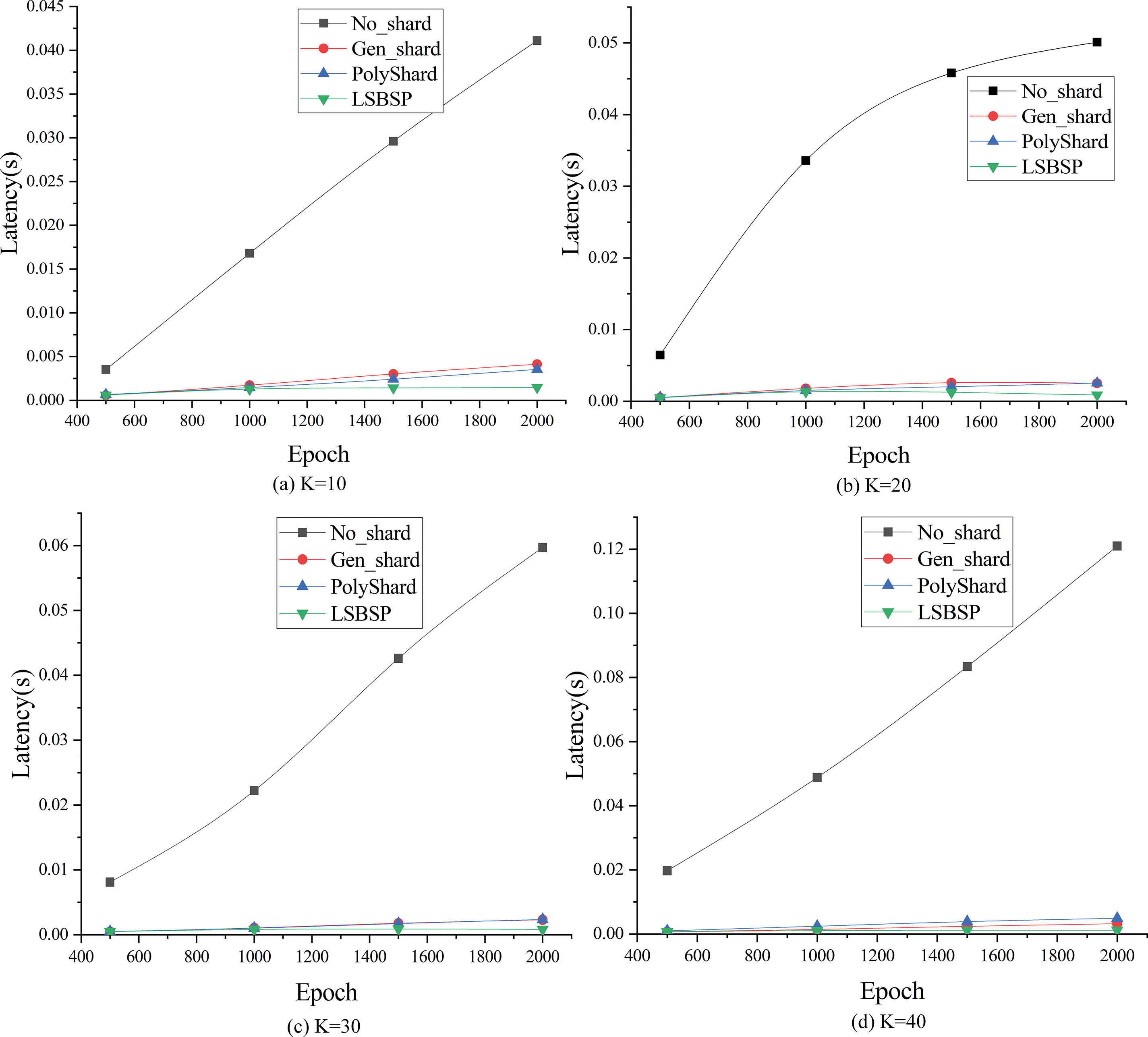
Figure 8: The latency under different number of shards
Notably, the latency of the No_shard scheme increases linearly with epoch size. The Gen_shard and PolyShard protocols perform well with smaller epochs but experience heightened latency as epoch sizes increase. This is due to more transactions being packed into each block, resulting in a larger number of blocks generated within each shard, which extends the time needed to validate historical blocks, thereby lengthening transaction processing times. In contrast, the LSBSP scheme exhibits strong performance as it prunes historical blocks, reducing the validation time and streamlining the process. When
6.4 Bootstrap Overhead Analysis
This section explores the additional storage capacity costs incurred by a verification node when it joins and undergoes the state bootstrap process within the network. In the No_shard scheme, all nodes must store the entire ledger to facilitate transaction verification. However, in PolyShard, as the number of blocks appended to each shard grows, the computational complexity of block verification also increases. Verifiers create a comprehensive ledger copy by executing historical transactions within the blockchain, leading to a linear surge in state bootstrap overhead as the block height rises. To mitigate this storage consumption, LSBSP periodically generates snapshots and retrieves the latest state data from them. Assuming an average block size of 1.52 MB, Fig. 9 illustrates how the size of the node’s bootstrapping state varies as the number of blocks increases in both LSBSP and Polyshard schemes. Polyshard exhibits a linear growth in storage overhead, whereas LSBSP maintains a relatively stable storage overhead.
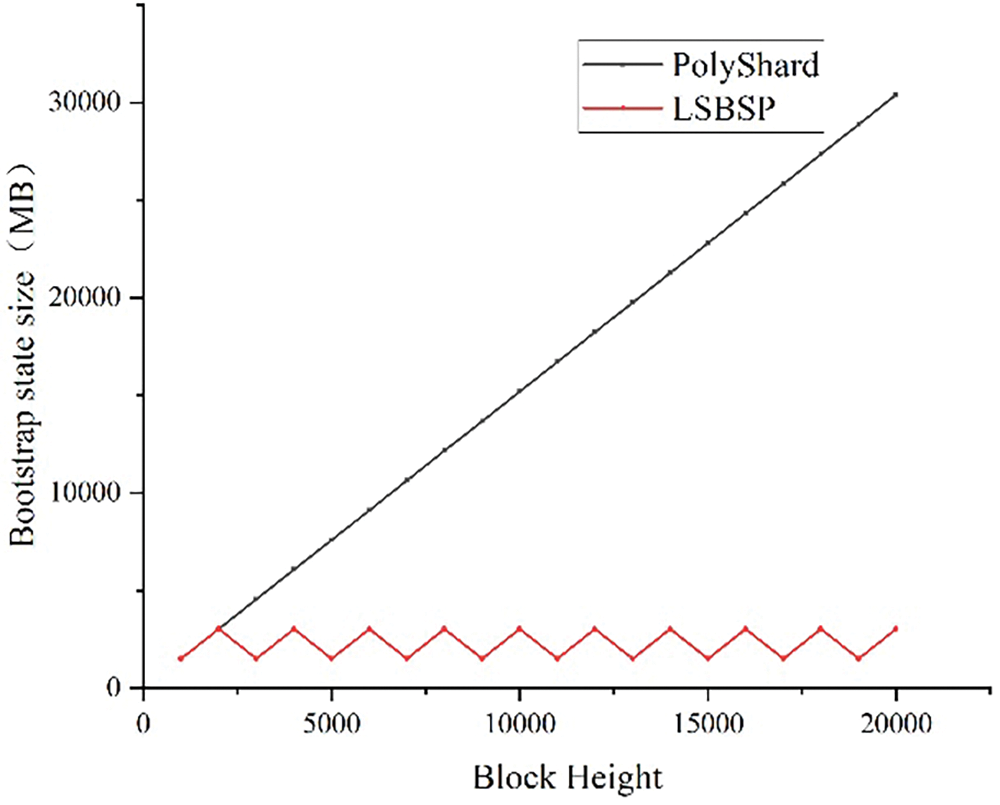
Figure 9: The overhead of state bootstrapping
Blockchain technology is playing a pivotal role in addressing various healthcare challenges, from safeguarding patient data to enhancing the efficient of EHR data sharing. However, in practical applications, blockchain for electronic medical records often functions as a generic data storage system, resulting in the accumulation of a vast amount of ledger data that includes numerous outdated and infrequently used entries [34]. Traditionally, validators are required to download and indefinitely store all ledger information, which not only imposes a significant burden on network nodes but also increases the risk of centralization [35]. To address the latency issues in real time IoT applications, the LSBSP model optimizes storage and reduces system latency, enhancing responsiveness. By selectively pruning outdated or infrequently accessed data from the blockchain, LSBSP minimizes the active ledger size, lowering retrieval times and overall processing delays.
As depicted in Fig. 10, data collectors upload electronic health records to the EHR blockchain. The LSBSP model enhances real-time performance by employing dual-chain structure that efficiently prune historical data. For example, medical records that have not been accessed or updated in over five years can be removed from the SC, ensuring that only relevant, recent data remains. This approach significantly reduces the storage and retrieval load on blockchain nodes, allowing the network to handle real-time IoMT transactions more effectively.

Figure 10: Application of LSBSP in the medical electronic health records blockchain
The LSBSP model addresses key security challenges in healthcare, including data confidentiality, integrity, and unauthorized access. By regularly pruning historical data, LSBSP limits access to recent records only, reducing exposure to older, sensitive information and mitigating risks of unauthorized access. Additionally, it can apply encryption to critical data blocks, ensuring access is restricted to authorized entities. To counter replay attacks, which may retransmit valid data to compromise records, LSBSP retains only recent validated snapshots, with hash-based verification maintaining data integrity and resistance to tampering. Against DoS threats, the model’s pruning mechanism reduces data load, easing validation demands and bolstering resilience under high request volumes.
This article addresses data management and sharing challenges by introducing a lightweight blockchain sharding method that leverages snapshot technology. The LSBSP protocol combines state pruning with sharding to reduce storage demands on network nodes effectively. Through parallel transaction processing, this approach minimizes the typical overhead associated with sharding state bootstrapping, enhancing blockchain processing efficiency. Theoretical analysis and experimental results show that LSBSP outperforms existing sharding schemes in scalability and overhead reduction.
Currently, the solution lacks sufficient flexibility to dynamically adjust to fluctuating workloads, which may affect performance in high variable environments. To address this, future work will explore advanced optimization techniques, including AI-driven automated shard resizing and enhanced fault tolerance through redundancy protocols and recovery mechanisms, ensuring continuity during node failures. Furthermore, we plan to pursue real-world deployment within large scale IoMT ecosystems. This will involve pilot testing with healthcare providers to evaluate its practicality and identify areas for improvement. We also intend to strengthen security by incorporating advanced cryptographic methods to protect sensitive data, alongside machine learning techniques to predict transaction patterns and dynamically optimize shard management. Collectively, these efforts aim to create a more robust, secure, and effective data management and sharing framework, tailored to the rigorous demands of IoMT applications.
Acknowledgement: The authors express gratitude to the research group members for their support.
Funding Statement: This work is supported by the National Natural Science Foundation of China (62272207), the Key Project of Natural Science Foundation of Jiangxi Province (20224ACB202009), the Science and Technology Project of the Department of Education of Jiangxi Province (GJJ2200925) and the Jiangxi Provincial Health Commission Science and Technology Plan (202311147).
Author Contributions: The authors confirm contribution to the paper as follows: Methodology and design: Guoqiong Liao; Algorithm design and experimental analysis: Yinxiang Lei; Data analysis: Yufang Xie; Review and supervision: Neal N. Xiong. All authors reviewed the results and approved the final version of the manuscript.
Availability of Data and Materials: The data supporting this study are available from the corresponding author upon reasonable request.
Ethics Approval: Not applicable.
Conflicts of Interest: The authors declare no conflicts of interest to report regarding the present study.
References
1. A. Heidari, N. J. Navimipour, H. Dag, S. Talebi, and M. Unal, “A novel blockchain-based deepfake detection method using federated and deep learning models,” Cognit. Comput., vol. 16, no. 3, pp. 1073–1091, 2024. doi: 10.1007/s12559-024-10255-7. [Google Scholar] [CrossRef]
2. A. Qashlan, P. Nanda, and M. Mohanty, “Differential privacy model for blockchain based smart home architecture,” Future Gener. Comput. Syst., vol. 150, pp. 49–63, 2024. doi: 10.1016/j.future.2023.08.010. [Google Scholar] [CrossRef]
3. H. Xu, S. Qi, Y. Qi, W. Wei, and N. Xiong, “Secure and lightweight blockchain-based truthful data trading for real-time vehicular crowdsensing,” ACM Trans. Embed. Comput. Syst., vol. 23, no. 1, pp. 1–31, 2024. doi: 10.1145/3687309. [Google Scholar] [CrossRef]
4. S. Datta and S. Namasudra, “Blockchain-based smart contract model for securing healthcare transactions by using consumer electronics and mobile-edge computing,” IEEE Trans. Consum. Electron., vol. 70, no. 1, pp. 4026–4036, 2024. doi: 10.1109/TCE.2024.3357115. [Google Scholar] [CrossRef]
5. G. A. F. Rebello et al., “A survey on blockchain scalability: From hardware to layer-two protocols,” IEEE Commun. Surv. Tutor., vol. 26, no. 4, pp. 2411–2458, 2024. doi: 10.1109/COMST.2024.3376252. [Google Scholar] [CrossRef]
6. L. Luu, V. Narayanan, C. Zheng, K. Baweja, S. Gilbert and P. Saxena, “A secure sharding protocol for open blockchains,” in Proc. 2016 ACM SIGSAC Conf. Comput. Commun. Secur., New York, NY, USA, 2016, pp. 17–30. [Google Scholar]
7. E. Kokoris-Kogias, P. Jovanovic, L. Gasser, N. Gailly, E. Syta and B. Ford, “OmniLedger: A secure, scale-out, decentralized ledger via sharding,” in Proc. 2018 IEEE Symp. Secur. Priv. (SP), 2018, pp. 583–598. [Google Scholar]
8. M. Zamani, M. Movahedi, and M. Raykova, “RapidChain: Scaling blockchain via full sharding,” in Proc. 2018 ACM SIGSAC Conf. Comput. Commun. Secur., New York, NY, USA, 2018, pp. 931–948. [Google Scholar]
9. H. Luo, “ULS-PBFT: An ultra-low storage overhead PBFT consensus for blockchain,” Blockchain Res. Appl., vol. 4, no. 4, 2023, Art. no. 100155. doi: 10.1016/j.bcra.2023.100155. [Google Scholar] [CrossRef]
10. S. Yuan, B. Cao, Y. Sun, Z. Wan, and M. Peng, “Secure and efficient federated learning through layering and sharding blockchain,” IEEE Trans. Netw. Sci. Eng., vol. 11, no. 3, pp. 3120–3134, 2024. doi: 10.1109/TNSE.2024.3361458. [Google Scholar] [CrossRef]
11. F. Hu, S. Qiu, X. Yang, C. Wu, M. B. Nunes and H. Chen, “Privacy preserving healthcare and medical data collaboration service system based on blockchain and federated learning,” Comput. Mater. Contin., vol. 80, no. 2, pp. 1–10, 2024. doi: 10.32604/cmc.2024.052570. [Google Scholar] [CrossRef]
12. Z. Zhen, X. Wang, H. Lin, S. Garg, P. Kumar and M. S. Hossain, “A dynamic state sharding blockchain architecture for scalable and secure crowdsourcing systems,” J. Netw. Comput. Appl., vol. 222, 2024, Art. no. 103785. doi: 10.1016/j.jnca.2023.103785. [Google Scholar] [CrossRef]
13. R. Rana, S. Kannan, D. Tse, and P. Viswanath, “Free2Shard: Adversary-resistant distributed resource allocation for blockchains,” Proc. ACM Meas. Anal. Comput. Syst., vol. 6, no. 1, pp. 1–38, 2022. [Google Scholar]
14. S. Li, M. Yu, C. -S. Yang, A. S. Avestimehr, S. Kannan and P. Viswanath, “PolyShard: Coded sharding achieves linearly scaling efficiency and security simultaneously,” IEEE Trans. Inf. Forensics Secur., vol. 16, pp. 249–261, 2021. doi: 10.1109/TIFS.2020.3009610. [Google Scholar] [CrossRef]
15. M. Li, X. Luo, K. Xue, Y. Xue, W. Sun and J. Li, “A secure and efficient blockchain sharding scheme via hybrid consensus and dynamic management,” IEEE Trans. Inf. Forensics Secur., vol. 19, pp. 5911–5924, 2024. doi: 10.1109/TIFS.2024.3406145. [Google Scholar] [CrossRef]
16. Y. Xu, J. Zheng, B. Düdder, T. Slaats, and Y. Zhou, “A two-layer blockchain sharding protocol leveraging safety and liveness for enhanced performance,” in Proc. 2024 Netw. Distrib. Syst. Secur. (NDSS) Symp., San Diego, CA, USA, 2024. [Google Scholar]
17. A. Vakili, H. M. R. Al-Khafaji, M. Darbandi, A. Heidari, N. J. Navimipour and M. Unal, “A new service composition method in the cloud-based internet of things environment using a grey wolf optimization algorithm and mapReduce framework,” Concurr. Comput.: Pract. Exp., vol. 36, no. 16, 2024, Art. no. e8091. doi: 10.1002/cpe.8091. [Google Scholar] [CrossRef]
18. J. Zhang, W. Chen, S. Luo, T. Gong, Z. Hong and A. Kate, “Front-running attack in sharded blockchains and fair cross-shard consensus,” in Netw. Distrib. Syst. Secur. Symp. (NDSS), San Diego, CA, USA, 2024. [Google Scholar]
19. J. Xu, Y. Ming, Z. Wu, C. Wang, and X. Jia, “X-Shard: Optimistic cross-shard transaction processing for sharding-based blockchains,” IEEE Trans. Parallel Distrib. Syst., vol. 35, no. 4, pp. 548–559, 2024. doi: 10.1109/TPDS.2024.3361180. [Google Scholar] [CrossRef]
20. Y. Tao, B. Li, J. Jiang, H. C. Ng, C. Wang and B. Li, “On sharding open blockchains with smart contracts,” in Proc. 36th Int. Conf. Data Eng. (ICDE), 2020, pp. 1357–1368. [Google Scholar]
21. Z. Hong, S. Guo, E. Zhou, W. Chen, and H. Huang, “GriDB: Scaling blockchain database via sharding and off-chain cross-shard mechanism,” Proc. VLDB Endowment, vol. 16, no. 7, pp. 1685–1698, 2023. doi: 10.14778/3587136.3587143. [Google Scholar] [CrossRef]
22. L. Ren, W. -T. Chen, and P. A. S. Ward, “SnapshotSave: Fast and low storage demand blockchain bootstrapping,” in Proc. 36th Annu. ACM Symp. Appl. Comput., New York, NY, USA, 2021, pp. 291–300. [Google Scholar]
23. J. W. Heo, G. S. Ramachandran, A. Dorri, and R. Jurdak, “Blockchain data storage optimisations: A comprehensive survey,” ACM Comput. Surv., vol. 56, no. 7, pp. 1–27, Apr. 2024. doi: 10.1145/3645104. [Google Scholar] [CrossRef]
24. R. Matzutt, B. Kalde, J. Pennekamp, A. Drichel, M. Henze and K. Wehrle, “CoinPrune: Shrinking bitcoin’s blockchain retrospectively,” IEEE Trans. Netw. Serv. Manage., vol. 18, no. 3, pp. 3064–3078, 2021. doi: 10.1109/TNSM.2021.3073270. [Google Scholar] [CrossRef]
25. K. Suresh, K. Anand, G. Nagappan, and R. Pugalenthi, “A blockchain based cloud file storage system using fuzzy based hybrid flash butterfly optimization approach for storage weight reduction,” Int. J. Fuzzy Syst., vol. 26, no. 3, pp. 978–991, 2024. doi: 10.1007/s40815-023-01645-4. [Google Scholar] [CrossRef]
26. C. Wang, K. Wang, M. Li, F. Wei, and N. Xiong, “Chunk2vec: A novel resemblance detection scheme based on sentence bert for post deduplication delta compression in network transmission,” IET Commun., vol. 18, no. 2, pp. 145–159, 2024. doi: 10.1049/cmu2.12719. [Google Scholar] [CrossRef]
27. A. Heidari, N. J. Navimipour, H. Dag, and M. Unal, “Deepfake detection using deep learning methods: A systematic and comprehensive review,” WIREs Data Min. Knowl., vol. 14, no. 2, 2024, Art. no. e1520. doi: 10.1002/widm.1520. [Google Scholar] [CrossRef]
28. Y. Q. Fan, D. Sheng, and L. F. Wang, “Blockchain storage optimization based on erasure codes,” J. Comput., vol. 45, no. 4, pp. 858–876, 2022. [Google Scholar]
29. X. Qi, Z. Zhang, C. Jin, and A. Zhou, “A reliable storage partition for permissioned blockchain,” IEEE Trans. Knowl. Data Eng., vol. 33, no. 1, pp. 14–27, 2021. doi: 10.1109/TKDE.2020.3012668. [Google Scholar] [CrossRef]
30. P. Huang, X. Ren, T. Huang, A. S. Voundi Koe, D. S. Wong and H. Jiang, “SnapshotPrune: A novel bitcoin-based protocol toward efficient pruning and fast node bootstrapping,” Tsinghua Sci. Technol., vol. 29, no. 4, pp. 1037–1052, 2024. doi: 10.26599/TST.2023.9010014. [Google Scholar] [CrossRef]
31. R. Kumar, R. Tripathi, N. Marchang, G. Srivastava, T. R. Gadekallu and N. N. Xiong, “A secured distributed detection system based on IFPS and blockchain for industrial image and video data security,” J. Parallel Distr. Comput., vol. 152, pp. 128–143, 2021. doi: 10.1016/j.jpdc.2021.02.022. [Google Scholar] [CrossRef]
32. J. Wang, J. Chen, N. Xiong, O. Alfarraj, A. Tolba and Y. Ren, “S-BDS: An effective blockchain-based data storage scheme in zero-trust IoT,” ACM Trans. Internet Technol., vol. 23, no. 3, pp. 1–23, 2023. doi: 10.1145/3511902. [Google Scholar] [CrossRef]
33. F. Yang, Z. Ding, L. Jia, Y. Sun, and Q. Zhu, “Blockchain-based file replication for data availability of IPFS consumers,” IEEE Trans. Consum. Electron., vol. 70, no. 1, pp. 1191–1204, 2024. doi: 10.1109/TCE.2024.3364237. [Google Scholar] [CrossRef]
34. Z. Sun, D. Han, D. Li, T. -H. Weng, K. -C. Li and X. Mei, “MedRSS: A blockchain-based scheme for secure storage and sharing of medical records,” Comput. Ind. Eng., vol. 183, 2023, Art. no. 109521. doi: 10.1016/j.cie.2023.109521. [Google Scholar] [CrossRef]
35. T. Benil and J. Jasper, “Blockchain based secure medical data outsourcing with data deduplication in cloud environment,” Comput. Commun., vol. 209, pp. 1–13, 2023. doi: 10.1016/j.comcom.2023.06.013. [Google Scholar] [CrossRef]
Cite This Article
 Copyright © 2025 The Author(s). Published by Tech Science Press.
Copyright © 2025 The Author(s). Published by Tech Science Press.This work is licensed under a Creative Commons Attribution 4.0 International License , which permits unrestricted use, distribution, and reproduction in any medium, provided the original work is properly cited.


 Submit a Paper
Submit a Paper Propose a Special lssue
Propose a Special lssue View Full Text
View Full Text Download PDF
Download PDF Downloads
Downloads
 Citation Tools
Citation Tools